#pakistan news 2020
Explore tagged Tumblr posts
Text
#army public school aps murree road rawalpindi jobs 2022#aps kuldana jobs 2023#2023 aps kuldana jobs#balochistan public service commission jobs 2023#public service commission jobs 2023#federal public service commission jobs 2023#new jobs 2023 in pakistan today#latest jobs vacancies 2023#patriata chairlift and cable car murree#army school admission form 2020#murree patriata chair lift 2022#jobs in pakistan 2023#balochistan public#govt jobs in pakistan 2023
0 notes
Text
While perhaps it's too early to call it a "masterstroke", Joe Biden stepping aside for Kamala Harris will probably turn out much better than any Democrat would have predicted a month ago.
Kamala Harris will likely be the next president of the United States – and that’s overall good news if you care about democracy, justice and equality. Joe Biden’s decision on Sunday to bow out of the presidential race clears the path for the country to elect its first woman and first woman of color as president.
For people who need a historical reminder...
[M]ost people in this country typically choose the Democratic nominee for president over the Republican nominee time and time again. With the sole exception of 2004, in every presidential election since 1992, the Democratic nominee has won the popular vote (Biden bested Donald Trump by 7m votes in 2020).
Now for more recent events.
If, in fact, support for Democrats among people of color is the principal problem, then putting Harris at the top of the ticket is a master stroke. The enthusiasm for electing the first woman of color as president will likely be a thunderclap across the country that consolidates the support of voters of color, and, equally important, motivates them to turn out in large numbers at the polls, much as they did for Barack Obama in 2008. The challenge the party will face in November is holding the support of Democratic-leaning and other “gettable” whites, especially given the electorate’s tortured history in embracing supremely qualified female candidates such as Hillary Clinton and Stacey Abrams. (The primary difference between Abrams, who lost in Georgia, and Senator Raphael Warnock, who won, is gender.) Sexism, misogyny and sexist attitudes about who should be the leader of the free world are real and Democrats will have to work hard to address that challenge. One critical step to solidifying the Democratic base is for all political leaders to quickly and forcefully endorse and embrace Harris’s candidacy. Mathematically, it is likely – and certainly possible, if massive investments are made in getting out the vote of people of color and young people as soon as possible – that the gains for Democrats will offset any losses among whites worried about a woman (and one of color, no less) occupying the Oval Office and becoming our nation’s commander in chief.
We shouldn't forget that the VP's mom was born in India. A number of people in the growing South Asian community in the US who may not be especially interested in politics will be tempted to pause their disinterest and vote for Kamala. India, Pakistan, and Bangladesh have all had female prime ministers – so there's not exactly a taboo about women in power.
One way to measure enthusiasm for Kamala is to look at how much money is being raised by ActBlue. Not all the money ActBlue raises goes to the national ticket. I donated to a US Senate campaign in June via ActBlue. BUT the timing of recent donations leaves little doubt what the cause of the recent spike is.
For context, first some recent weekly totals (source)...
Week of June 30 through July 6 — $65,220,920
Week of July 7 through July 13 — $48,669,913
Week of July 14 through July 20 — $61,349,601
As of Noon today (CDT): Week of July 21 through July 27th — $150,042,360 and the third day of the week is just a little over half over. In the previous hour alone, roughly $2.44 million was raised.
These are small donations, not like the $45 million per month promised by multi-billionaire Elon Putz to Trump. So grassroots Dems are stoked and are out for a win.
ActBlue is fairly no-nonsense, it's not exactly Amazon in layout. So people are not drawn there by flashy graphics.
Kamala Harris — Donate via ActBlue
#kamala harris#democrats#people of color#potus#steve phillips#voter enthusiasm#political contributions#actblue#election 2024#vote blue no matter who
85 notes
·
View notes
Note
I think that religion should not be the basis of a state, nor should it influences laws or customs. Like the abortion bans and hatred of queer ppl derived from Christianity here in the US. Many people are trying to get the US to be a truly secular society not just a culturally Christian one. All those ma countries in SWANA in which slavery is commonplace and misogyny is abound are not cool either. So, Israel is not justified in being based on Judaism or whatever.
I think all states should be for all people. Not just a particular bunch.
Anon meant these comments as condemnation of Israel, but let's apply Anon's criticisms to modern nation states and see which countries Anon would need to condemn:
There are currently three nations whose very names make clear that their national identity is based on Islam. These three are:
Anon wrote: "I think that religion should not be the basis of state..."
1. The Islamic Republic of Pakistan
2. The Islamic Republic of Mauritania
3. The Islamic Republic of Iran
Will you call for their dissolution?
Anon wrote: "I think that religion should not be the basis of state, nor should it influence laws or customs"
Okay, let's apply this standard to states which exist right now. This info is from Wikipedia, but I'll welcome any corrections if anyone can document errors here. This is nowhere near a complete list - these are just a handful of the nations in which Islamic faith and Sharia make laws to which non-Muslims are subject:
In Algeria, article 222 of the Family Code of 1983 specifies Sharia as the residuary source of laws.
...
Article 2 of Egypt's 2014 Constitution declares the principles of Sharia to be the main source of legislation. Egypt's law and enforcement system are in flux since its 2011 revolution; however, the declaration of Sharia's primacy in Article 2 is a potential ground for unconstitutionality of any secular laws in Egyptian legal code. Sharia courts and judges are run and licensed by the Ministry of Justice. The personal status law that regulates matters such as marriage, divorce and child custody is governed by Sharia. In a family court, a woman's testimony is worth half of a man's testimony.
...
In Mauritania, the Penal Code contains Sharia crimes such as heresy, apostasy, atheism, refusal to pray, adultery and alcohol consumption. Punishments include stoning, amputation and lashing. ...
How about Morocco? In 1956, a Code of Personal Status (Mudawana) was issued, based on dominant Maliki school of Sharia jurisprudence. Regional Sharia courts also hear personal status cases on appeal. In matters of family law, a woman's testimony is worth only half of that of a man. With 2003 reforms of its criminal law, Article 222 of its new criminal code is derived from Sharia; Articles 220–221, 268–272 of its criminal law similarly codify those activities as crimes that are prohibited under Sharia. Morocco adopted a new constitution in 2011; Article 41 of this constitution granted sole power to the Superior Council of the Ulemas to guide its laws through fatwas.
...
Sharia has been previously declared the chief source of all legislation in Sudan's 1968, 1973 and 1998 Constitutions. In 2005, Sudan adopted an interim national constitution; it removed some references to Sharia, but included Sharia-derived criminal, civil and personal legal codes, as well as Sharia-mandated hudud punishments. The Criminal Act of 1991 prescribes punishments which include forty lashes for drinking alcohol, amputation of the right hand for theft of a certain value and stoning for adultery.
However, there is no record of either any amputation or stoning ever having taken place in Sudan. The use of Sharia in Sudan ended in September 2020, when Sudan officially became a secular state after Sudan's transitional government agreed to separate religion from the state, ending 30 years of Islamic rule and Islam as the official state religion in the North African nation. It also scrapped the apostasy law and public flogging. However, after 1 year of military coup took place, Sharia got installed once again and harsh punishment like floggings still exist according to article 146. ... In Iran, Article 167 of the constitution states that all judicial rulings must be based upon "authoritative Islamic sources and authentic fatwa". Book 2 of the Islamic Penal Code of Iran is entirely devoted to hudud punishments. Iranian application of Sharia has been seen by scholars as highly flexible and directly contradicting traditional interpretations of the Sharia.
...
In Iraq, Article 1 of the Civil Code identifies Sharia as a main source of legislation. The 1958 Code "made polygamy extremely difficult, granted child custody to the mother in case of divorce, [and] prohibited repudiation and marriage under the age of 16." In 1995, Iraq introduced Sharia punishment for certain types of criminal offenses. Iraq's legal system is based on Islamic Sunni and Jafari (Shi’ite) interpretations of Sharia. Article 41 of the constitution allows for personal status matters (such as marriage, divorce and inheritance) to be governed by the rules of each religious group. The article has not yet been put into effect, and a unified personal status law remains in place that builds on the 1959 personal status code. ...
The Constitution of Pakistan acknowledges God as the sole sovereign of the universe and the Parliament as a delegate. The Constitution of Pakistan requires that all laws conform with Islam and not conflict with the Quran or Sunnah. The Council of Islamic Ideology reviewed the British era legislation and found most of it did not conflict with Sharia. Sharia was declared the Supreme Law of Pakistan in the 1991 Enforcement of Shariat Act. Section 4 stipulates that courts select an interpretation of law consistent with Islamic jurisprudence and principles.
...
Sharia is the main source of Qatari legislation according to Qatar's Constitution. Sharia is applied to laws pertaining to family law, inheritance, and several criminal acts (including adultery, robbery and murder). In some cases in Sharia-based family courts, a female's testimony is worth half a man's and in some cases a female witness is not accepted at all.
Anon wrote: "I think states should be for all people. Not just a particular bunch."
I think it is very easy to say that when one is a Christian or a a Muslim...or even just culturally Christian or culturally Muslim.
There are 57 Muslim countries in the world, according to the Organisation of Islamic Cooperation's (OIC) member list. Among these, 49 countries have a Muslim-majority population. Will you call for their destruction?
Christians make up a majority of the population in 157 countries and territories. Today, several nations officially identify themselves as Christian states or have state churches. These countries include Argentina, Armenia, Costa Rica, El Salvador, Denmark (incl. Greenland and the Faroes), England,Georgia, Greece, Hungary, Iceland, Liechtenstein, Malta, Monaco, Norway, Samoa, Serbia, Tonga, Tuvalu, Vatican City, and Zambia. Will you call for their dissolution?
So why, Anon, do you single out the world's only Jewish state, a particularly small state, for special criticism? How do you expect Israelis and Jews to see this as something other than a double standard, hypocrisy, and antisemtism?
Neither Christian nations or Muslim nations have a good history of protecting the rights of Jews as a religious identity or as an enthic identity. The Jews who survived the ethnic cleansings of Europe, the Middle East, and Africa? They went to Israel. That's Israel's population. That's what Israel is.
Meanwhile, let's look at religious freedom in Israel, the world's only Jewish state, which you single out for criticism:
The Declaration of the Establishment of the State of Israel (1948) guarantees freedom of religion for all. Each religious community is free, by law and in practice, to exercise its faith, to observe its holidays and weekly day of rest, and to administer its internal affairs. Each has its own religious council and courts, recognized by law and with jurisdiction over all religious affairs and matters of personal status such as marriage and divorce. Each has its own unique places of worship, with traditional rituals and special architectural features developed over the centuries.
Please tell me what rights the Jewish state denies to non-Jewish Israelis?
Tell me how Israel fails to protect the rights of women?
Tell me how Israel fails to protect the rights of its LGBTQ+ communities?
Please compare Israel to its neighbors on these things, Anon, and you'll understand why your attempt to suggest Israel is no better than it's neighbors is genuinely offensive to people who know better. When you hear anyone call Israel "Jewish Supremacist" or "apartheid state" or "theocracy," you know immediately that that person is either painfully ignorant of verifiable facts or a dishonest propagandist.
I don't know you, Anon. I assume you're young and not a student of history or political science.
I'm assuming that you're ignorant, not malicious. I think that this is the case for a majority of the Western, Leftist anti-Israel activists. I don't think you seek to be a bigot, I think your bigotry is a product of ignorance and I want to provide the verifiably truthful information you're missing.
I appreciate, though, how @#&*ing tired many Israelis and Jews are of dealing with these hypocritical double standards and the denial that they continue only because the anti-Israel crowds have one standard for Jews...and a different standard for everyone else.
It's ridiculous. It can't be supported by reason, it's not ideologically or logically consistent, so it's just bigotry.
When confronting these absurd circumstances where Israel is held to a standard which is applied to no other nation on earth, Jews in the US mostly find it both outrageous and frightening because we thought we shared the same values as our liberal non-Jewish friends.
But Israeli Jews, I think, don't have any more fucks to give about western Leftist ignorance or malice...and I don't blame them.
Meanwhile, here in the US, we have a xenophobic, Christian Nationalist president-elect set to take power in January with his party in majority in both our national legislative houses, and a Conservative Christian majority on the Supreme Court. I'm much more worried about the continuance of religious freedoms for religious minorities in the US than in Israel in 2025. I fear the rise of an American Christian Taliban, but I think (and hope) Israeli politics will keep their Israeli parallels (like Ben-Gvir and Smotrich) in check. Trump is likely to attack US Muslims. He will likely apply another travel ban. I fear he'll erode religious freedoms for all, but I'm particularly worried about potential attacks by Trump's party on US Muslim communities. The ADL's leader, Jonathan Greenblatt, was appalled in 2015 and 2016 when Trump proposed a Muslim Registry in the US. Know what he said?
"If one day Muslim Americans will be forced to register their identities, then that is the day that this proud Jew will register as a Muslim."
That's emblematic of who most US Jews are and I'm very proud of that. That's why we're the only polled religious group in the US which overwhelmingly voted for Harris. We know what Trump is. We recognize the signs. Harris supported Liberal values, Trump threatens them.
Read history, Anon. Read political science and political theory. Learn what the modern nation state *is*
A modern nation state is made up of a geographical territory and a people who identify as a nation. By definition, that's always a "particular bunch." That doesn't mean necessarily religiously or ethnically uniform (thank goodness), but there are no successful states without a broadly shared sense of national identity, and that is frequently built on identities which are based on ethicity, religion, or ideology (including civic, secular, pluralistic ideology). Read about naturalization processes in nations you think are good and successfully supporting a pluralistic society.
Please feel free to send more asks or messages.
Wishing you a happy new year and hoping that you, wherever you live, enjoy as much freedom as non-Jewish Israelis will continue to enjoy in 2025.
#hate mail#asks#jumblr#israel#antisemitism#jewblr#jewish tumblr#jewish#i/p#Religion#Law#Nations#States#nation states#establishment of religion#state religions#Christian nationalism#Not really hate mail... Ignorance mail?
27 notes
·
View notes
Text
This Olympics has been so much. In no particular order, we've got:
Cockblock pole vault guy (Anthony Ammirati)
Simone Biles's nth gold medal
Katie Ledecky finishing 8 full seconds ahead of her competition in the 800m free
Sha'Carri Richardson's revenge from 2020
Snoop Dogg
Bigoted accusations against Imane Khelif and her subsequent gold
Pakistan's first gold since 1992, by an athlete that had to beg for a new javelin (Arshad Nadeem)
The Turkish sharpshooter memes (Yusuf Dikeç)
The pommel horse guy (Stephen Nedoroscik)
Australia's confusing breakdancing performance (Rachel “Raygun” Gunn - which I have to give her, is a cool ass name)
The white girl from Lithuania wearing a durag (Dominika "Nicka" Banevič)
And this isn't even everything! So much has happened!
26 notes
·
View notes
Text
According to a new survey, lawmakers are playing an increasingly important role in holding corporations and governments accountable for failures to tackle the climate crisis.
The research was done by Columbia Law School, and was commissioned by the United Nations Environment Program (UNEP). It revealed that the number of climate-related court cases has more than doubled since 2017 and is steadily rising around the world.
Their report confirms a trend highlighted in the World Economic Forum’s Global Risks Report 2023, which claimed that individuals and environmental organizations were, more and more, turning to the law, as it became clear that the pace of transition to net-zero emissions was too slow.
“Climate litigation is increasing and concerns about emissions under-reporting and greenwashing have triggered calls for new regulatory oversight for the transition to net zero,” the Forum report said.
The UNEP report catalogues a number of high-profile court cases which have succeeded in enforcing climate action. In 2017, when climate case numbers were last counted, 884 legal actions had been brought. Today the total stands at 2,180.
The majority of climate cases to this date (1,522) have been brought in the US, followed by Australia, the UK, and the EU. The report notes that the number of legal actions in developing countries is growing, now at 17% of the total.
Climate litigation is also giving a voice to vulnerable groups who are being hard hit by climate change. The report says that, globally, 34 cases have been brought by children and young people, including two by girls aged seven and nine in Pakistan and India.
Here are five of the climate breakthroughs achieved by legal action so far.
1. Torres Strait Islanders Vs Australia
In September 2022, indigenous people living on islands in the Torres Strait between northern Queensland and Papua New Guinea won a landmark ruling that their human rights were being violated by the failure of the Australian government to take effective climate action.
The UN Human Rights Committee ruling established the principle that a country could be in breach of international human rights law over climate inaction. They ruled that Australia's poor climate record was a violation of the islanders’ right to family life and culture.
2. The Paris Agreement is a human rights treaty
In July 2022, Brazil's supreme court ruled that the Paris climate agreement is legally a human rights treaty which, it said, meant that it automatically overruled any domestic laws which conflicted with the country’s climate obligations.
The ruling ordered the government to reopen its national climate mitigation fund, which had been established under the Paris Agreement.
3. Climate inaction is a breach of human rights
Upholding an earlier court ruling that greenhouse emissions must be cut by 25% by 2020, the Netherlands Supreme Court ruled that failure to curb emissions was a breach of the European Convention on Human Rights.
The December 2019 ruling stated that, although it was up to politicians to decide how to make the emission cuts, failure to do so would be a breach of Articles 2 and 8 of the Convention which affirm the right to life and respect for private and family life.
4. Companies are bound by the Paris accord
Corporations, and not just governments, must abide by the emissions reductions agreed in the Paris climate treaty. This principle was established by a 2021 ruling in the Netherlands brought by environmentalists against energy group Royal Dutch Shell.
The court ordered Shell to cut its CO2 emissions by 45% by 2030 bringing them in line with Paris climate targets. The judge was reported as saying there was "worldwide agreement" that a 45% reduction was needed, adding: "This applies to the entire world, so also to Shell”.
5. Courts overturn state climate plans
Up until now, three European governments have been defeated in the courts over their climate plans.
In March 2021, Germany’s highest court struck down a climate law requiring 55% emissions by 2030 cuts, ruling it did not do enough to protect citizens’ rights to life and health. The same year, the French government was ordered to take “immediate and concrete action” to comply with its climate commitments. And in 2022, the UK’s climate strategy was ruled unlawful for failing to spell out how emissions cuts would be made.
#climate change#climate#hope#good news#more to come#climate emergency#news#climate justice#hopeful#positive news#long post#important#good post#links#for future reference#law#climate law#paris agreement#paris climate agreement#government#democracy#politicians#economics#politics
60 notes
·
View notes
Text

2023
Pickleball. Generative AI. Lula takes office in Brazil, Amazon Rainforest throws a party. Prince Harry refusing to stop talking about his frozen penis no matter how many times society begged him to stop. UFOs are real. Viral cat dubbed ‘largest cat anyone has ever seen’ gets adopted. Pee-Wee’s big adventure ends. Musk & X. Turkey-Syria earthquake kills thousands. India surpasses China as ‘country squeezing in the most peeps’. Tucker Carlson ousted. Miss USA and her 30 lbs moon costume. Wildfires in Kelowna and Hawaii. Macron tinkers with retirement age of the French. Paltrow can’t ski. Big Red Boots. Bob Barker leaves us. Alabama mom delivers 2 babies from her 2 uteruses in 2 days. Charles III. Ukrainian counteroffensive against Russian forces as the war drags on. Taylor Swift is Time’s Person of the Year. African ‘coup belt’. Flo-Jo dies in her sleep. Chinese spy balloon shot down. Hollywood writers strike. Human ‘nice mugshot’ Shitstain and his 91 indictments. Highest interest rates in 2 decades. The Bear’s Christmas episode. War in Gaza. Shinzo Abe is assassinated. Alex Murdaugh. Ocean Cleanup removes 25 000 lbs of trash from the Great Pacific Garbage Patch. Vase purchased for $3.99 sells for $100 000 at auction. Barbenheimer. A third of Pakistan is flooded. Lionel Messi is the GOAT. Travis Kelce. The Sphere opens in Las Vegas. Regulators seized Silicon Valley Bank and Signature Bank, resulting in two of the three largest bank failures in U.S. history. “The Woman In Me”. WHO declares COVID ain’t a thing no more. Titan sub sinks, rich people die. Matthew Perry drowns. Dumbledore Dies (again). Massive sales of ‘Fuck Trudeau’ flags for jacked-up micro-dick trucks. Everything Everywhere All At Once. June-August was the hottest three-month period in recorded history across the Earth. Tina Turner dies. And the Beatles release a new song?! Wow… You got big shoes to fill 2024.
Archives for context:
2020
Kobe. Pandemic. Lockdown. Koalas on fire. Harry and Meg retire. Toilet paper hoarding. Alcoholism. Impeach the f*cker. Parasite. Bonnie Henry. Tiger King. Working from home. Sourdough bread. Harvey Weinstein guilty. Zoom overdose. Dip your body in sanitizer. 6 feet. Quarantine. OK Boomer. Home schooling (everyone passes). Murder hornets. Dolly Parton. Don’t hug, kiss or see anybody, especially your family. Chris Evans’ junk. TikTok. Glory holes. Face masks. CERB. West Coast wildfires. Stay home. Small Businesses lose, big box stores win. F*ck Bozos. ‘Dreams’ and cranberry juice. Close yoga studios, but thumbs up to your local gym. Speak moistly to me. George Floyd. BLM. F*ck Trump. Phase 2, 3 and Summer. RBG. Baby Yoda. Biden wins. Bond and Black Panther die. No more lockdown. Back to school and work. Just kidding... giddy up round 2. Giuliani leaks shit from his head. Resurgence of chess. UFOs are real. Restrictions. Dave Grohl admits defeat. Monolith. “F*ck... forgot my mask in the car”. No Christmas shenanigans allowed. Bubbles. Alex Trebek. Use the term ‘dumpster fire’ one too many times. Jupiter and Saturn form 'Christmas Star'. Happy New Year Bitches!!!! 2021... you better not sh*t the bed!!
2021
“We love you, you’re very special”. Failed coup attempt at the Capital. Twitter, FB and IG ban Donny. Hammerin’ Hank goes to the Field of Dreams. Bozo no longer richest man but still a twat. Leachman, Tyson, and Holbrook pass. The economy is worse than expected. Kim and Kanye split. Brood X cicadas. Dre has an aneurysm and nearly has his home broken into. Bridgerton. MyPillow CEO is a douche. Covid restrictions extended indefinitely. Captain Von Trapp dies. Proud Boys officially a Terrorist Organization. Richard Ramirez. Cancer takes Screech. Travel bans. Impeachment trial (again?… oh and this was barely February? WTF??!!) Suez Canal blockage. Myanmar protest. Kong dukes it out with Godzilla, while Raya watches. Olympics. Friends compare elective surgeries. F9. Canada Women’s Soccer Gold. Free Britney. Multiverses. Residential Schools in Canada unearth children’s bodies. Kate is Mare of Easttown. Cuomo resigns. Disney and Dwayne cruise together. Wildfires. Delta variants. Musk passes Bezos. Candyman x 5. Capt. Kirk goes to space. F*ck Kyle Rittenhouse. Astros didn’t win. Squid Game. Goodbye Bond. Dune is redone. Angelina is Eternal. Astroworld deaths. Meta. Omicron. Three Spidermen. Tornados in December? World Juniors cancelled. Pills against Covid. School opening delayed. And Betty White dies. 2022… my expectations are ridiculously low…
2022
Wow… eight billion people. Queen Elizabeth II passes away after ruling the Commonwealth before dirt was invented. The monkeypox. Russia plays the role of global a**hole. Wordle. Mother Nature rocks Afghanistan. Hover bike. Styles spits on Pine. Olivia Newton John, Kristie Alley, and Coolio leave us. Pele was traded to team Heaven. FTX implodes. Madonna and the 3-D model of her vagina. Pig gives his heart to a human. Beijing can brag that it is the first city ever to host both the Summer Olympics and Winter Olympics. Uvalde. $3 trillion Apple. Keith Raniere gets 120 years. The Whisky War ends with Canada and Denmark going halfsies. Mar-a-Lago. Nick Cannon brood hits a dozen. Shinzo Abe is assassinated. Inflation goes through the roof (if you can actually afford to put a roof over your head). Volodymyr Zelensky. European heat wave. Bennifer. Salman Rushdie is stabbed on stage, Dave Chappelle tackled, and Chris Rock is only slapped. Thích Nhất Hạnh. Heidi Klum goes full slug. Cuba knocked out by Ian. Liz Truss and 4.1 Scaramuccis. Taylor Swift breaks Ticketmaster. Human shitstain Elon Musk ignores helping mankind and buys Twitter instead. Riri becomes a mommy. NASA launches Artemis 1. Trump still a whiny little b*tch. Music lost Loretta Lynn, Christine McVie, and Meat Loaf. Democracy died at least three times. Pete Davidson continues to date hottest women on the planet (no one understands how?!) Microplastics in our blood. Alex Jones is a c*nt. So is DeSantis. Argentina wins the World Cup. Meghan and Harry. Eddie Munson rips Metallica in the Upside Down. tWitch. Roe vs Wade is overturned by the micro dick energy of the Supreme Court. CODA. James Corden shows he is a "tiny Cretin of a man". Amber (and the sh*t on the bed) Heard (round the world). Sebastian Bear-McClard proves he’s one of the f*cking dumbest men alive. Latin America's ‘pink tide’. Anti-Semitic rants by Ye. Bob Saget. A verified blue checkmark. Godmother of punk Vivienne dies. And, Tom Cruise feels the need for speed yet again. 2023… whatcha got for us?!? Nothing shocks me anymore.
@daily-esprit-descalier
25 notes
·
View notes
Text
Holidays 12.18
Holidays
Answer the Phone Like Buddy the Elf Day
Arabic Language Day (UN)
Australian Christmas (Team Fortress)
Baranth Do (Elder Scrolls)
Day with the Wallet Holder (Mexico)
Earl ‘DMX’ Simmons Day (New York)
Final Fantasy Anniversary Day
Flake Appreciation Day
Founder’s Day (Qatar)
Hug a Soccer Player Day
Incwala Day (Eswatini, f.k.a. Swaziland)
Insurance Employee Day (Kyrgyzstan)
International Migrants Day (UN)
Kissan Day (Pakistan)
López Jaena Day (Iloilo, Philippines)
Military Counterintelligence Day (Ukraine)
Minifig Day
National Crime Junkie Day
National Deborah Day
National HODL Day (Bitcoin)
National Jeremy Day
National Scrooge Week begins (according to Mr. Ed)
National Twin Day
Nutcracker Day
Nyempa Guzom (Sikkim, India)
Pink Panther Day
Play Bingo Day
Police Day (Moldova)
Republic Day (Niger)
Sunday Newspaper Day
Truffle Day (French Republic)
Tulya’s E’en (Beginning of Yule Season; Orkney Island)
University Unity Day (Iran)
Voice From Space Day
Wear a Plunger On Your Head Day
World Minorities Rights Day (India)
Yuletide Lad #7 arrives (Hurdaskellir or Door-Slammer; Iceland)
Food & Drink Celebrations
Bake Cookies Day
Let's See What We Find in the Fridge Day
National Ham Salad Day
National “I Love Honey” Day
National Muffin Day (Brazil)
National Roast Suckling Pig Day
National Stilton Day (UK)
Independence & Related Days
Egypt (Declared British Protectorate; 1914)
New Jersey Statehood Day (#3; 1787)
Qatar (1878)
3rd Wednesday in December
Hump Day [Every Wednesday]
National Early Signing Day (NCAA Football) [3rd Wednesday]
Wacky Wednesday [Every Wednesday]
Wandering Wednesday [3rd Wednesday of Each Month]
Website Wednesday [Every Wednesday]
Wiener Wednesday [3rd Wednesday of Each Month]
Weekly Holidays beginning December 18 (3rd Full Week of December)
Drive Sober or Get Pulled Over Week (thru 1.1.2025)
Winter Festival (Birth of the God Diev & Rebirth of the Sun; Latvia) [thru 12.20]
Festivals Beginning December 18, 2024
London International Horse Show (London, United Kingdom) [thru 12.22]
Night of the Proms (Erfurt, Germany)
Winter Festival (Birth of the God Diev & Rebirth of the Sun; Latvia) [thru 12.20]
Feast Days
Alfred Bester (Writerism)
Edward Willis Redfield (Artology)
Epona (Celtic Book of Days)
Eponalia (Feast of Epona; Roman goddess of fertility)
Expectation of the Blessed Virgin Mary (Christian)
Fantastic Finkleman (Muppetism)
Feast of Our Lady of Expectation
Feast of Our Lady of Solitude (Mexico)
Flannán (Christian; Saint)
Gatianus (a.k.a. Gatian) of Tours (Christian; Saint)
Jonathan Yeo (Artology)
Michael Moorcock (Writerism)
Mimmo Paladino (Artology)
O Adonai (2nd O Antiphon or Great Advent Antiphon; Christian) [2 of 7]
Paul Klee (Artology)
Priestley (Positivist; Saint)
Rufus and Zozimus (Christian; Martyrs)
Running of the Roboderos (Church of the SubGenius)
Saki (Writerism)
Saturnalia Day 2: Saturn’s Release (Pagan)
Sebastian (Eastern Orthodox Church)
Unusual Music Instruments Day (Pastafarian)
Urdhyauli Parwa (Festival of the Animals; Nepal)
Willem van de Velde II (Artology)
Winibald (a.k.a. Winebald; Christian; Saint)
Lucky & Unlucky Days
Butsumetsu (仏滅 Japan) [Unlucky all day.]
Tycho Brahe Unlucky Day (Scandinavia) [37 of 37]
Premieres
Anchorrman 2: The Legend Continues (Film; 2013)
Another Round (Film; 2020)
Avatar (Film; 2009)
Baby Buggy Bunny (WB MM Cartoon; 1954)
The Ballad of the Green Berets, recorded by Staff Sgt. Barry Sadler (Song; 1965)
*batteries not included (Film; 1987)
Bellboy Donald (Disney Cartoon; 1942)
The Big Blast or A Many Splintered Thing (Rocky & Bullwinkle Cartoon, S2, Ep. 81; 1960)
Boris Lends a Hand or Count Your Fingers (Rocky & Bullwinkle Cartoon, S4, Ep. 188; 1962)
Boris on a Broomstick or The Flying Sorceror (Rocky & Bullwinkle Cartoon, S4, Ep. 187; 1962)
Born to Boogie (Music Documentary Film; 1972)
Brazil (Film; 1985)
The Bridge on the River Kwai (Film; 1957)
Broadcast News (Film; 1987)
Caspar’s First Christmas (Hanna-Barbera Animated TV Special; 1979)
Chitty Chitty Bang Bang (Film; 1968)
Cholly Polly (Phantasies Cartoon; 1942)
Cinderella Liberty (Film; 1973)
The Color Purple (Film; 1985)
Doctor Faustus, by Christopher Marlowe (Play; 1592)
Dragons of Ashida (Animated TV Show; Jonny Quest #14; 1964)
A Flintstone Family Christmas (Hanna-Barbera Animated TV Special; 1993)
Her (Film; 2013)
Isle of Caprice (Ant and the Aardvark Cartoon; 1969)
The Lady in the Car with Glasses and a Gun (Film; 2015)
Last Train to Christmas (UK Film; 2021)
The Lion Sleeps Tonight, by The Tokens (Song; 1961)
Ma Rainey’s Black Bottom (TV Series; 2020)
McCartney III, by Paul McCartney (Album; 2020)
Moonstruck (Film; 1987)
Mother Goose in Swingtime (Color Rhapsody Cartoon; 1939)
The Nutcracker, by Pyotr Ilyich Tchaikovsky (Ballet; 1892)
On Her Majesty’s Secret Service (US Film; 1969) [James Bond #6]
Out of Africa (Film; 1985)
Overboard (Film; 1987)
The Painter and The Pointer (Andy Panda Cartoon; 1944)
Parking Space (Oswald the Lucky Rabbit Cartoon; 1933)
The Pink Phink (Pink Panther Cartoon; 1964)
The Prince of Egypt (Animated Film; 1998)
Riff Raffville, Parts 1 & 2 (Underdog Cartoon, S2, Eps. 45 & 46; 1965)
Twistin’ the Night Away, by Sam Cooke (Song; 1961)
The Two Towers (Film; 2002) [The Lord of the Rings #2]
September in the Rain (WB MM Cartoon; 1937)
Sisters (Film; 2015)
Star Wars: The Force Awakens (Film; 2015) [Star Wars #7]
The Steal Hour or A Snitch in Time (Rocky & Bullwinkle Cartoon, S2, Ep. 82; 1960)
Touché, Pussy Cat! (Tom & Jerry Cartoon; 1954)
The Yearling (Film; 1946)
You’ve Got Mail (Film; 1998)
Today’s Name Days
Philipp, Wunibald (Austria)
Bosiljko, Dražen, Gracijan, Malahija (Croatia)
Miloslav (Czech Republic)
Lovise (Denmark)
Neeme, Neemo (Estonia)
Aapo, Aappo, Rami (Finland)
Briac, Gatien (France)
Esperanza, Gratian, Luise (Germany)
Floros, Sebastianos (Greece)
Auguszta (Hungary)
Graziano (Italy)
Jordisa, Klinta, Kristaps, Sarmis (Latvia)
Eivilė, Girdvilas, Gracijus (Lithuania)
Kate, Kristoffer (Norway)
Bogusław, Gracjan, Gracjana, Laurencja, Wilibald, Wszemir (Poland)
Daniil (Romania)
Sláva (Slovakia)
Esperanza (Spain)
Abraham (Sweden)
Griffin, Griffith, Ruff, Rufina, Rufus, Russ, Russell, Rusti, Rusty, Ty, Tyrus (USA)
Today is Also…
Day of Year: Day 353 of 2024; 13 days remaining in the year
ISO: Day 3 of Week 51 of 2024
Celtic Tree Calendar: Ngetal (Reed) [Day 25 of 28]
Chinese: Month 11 (Bing-Zi), Day 18 (Bing-Chen)
Chinese Year of the: Dragon 4722 (until January 29, 2025) [Wu-Chen]
Hebrew: 17 Kislev 5785
Islamic: 16 Jumada II 1446
J Cal: 23 Black; Twosday [23 of 30]
Julian: 5 December 2024
Moon: 86%: Waning Gibbous
Positivist: 17 Bichat (13th Month) [Cavendish]
Runic Half Month: Jara (Year) [Day 12 of 15]
Season: Autumn or Fall (Day 87 of 90)
Week: 3rd Full Week of December
Zodiac: Sagittarius (Day 27 of 30)
3 notes
·
View notes
Text
By: Andrew Doyle
Published: Mar 8, 2024
Today is the fifth anniversary of the publication of Titania McGrath’s acclaimed book Woke: A Guide to Social Justice. I created this intersectional activist and slam poet in order to satirise this new intolerant and authoritarian identity-obsessed religion and its stranglehold on society. Having seen so many posh and entitled activists berating working-class straight white people for their privilege, I could think of no more appropriate reaction than mockery. Even Harry Windsor was at it. And he’s an actual prince.
Five years on, and I cannot decide whether I find it funny or depressing that so many of Titania’s ideas in that book ended up becoming reality. Nothing that Titania was ever able to suggest has not eventually been outdone by real-life activists. It is as though they were reading her book for inspiration.
For instance, in a chapter from Woke entitled “Towards an Intersectional Socialist Utopia”, Titania makes the following observation:
“Capitalism, after all, is a singularly male phenomenon. The ultimate symbol of capitalism, the skyscraper, is nothing more than a giant cock on the horizon, fucking the heavens.”
Sixteen months after the book was published, this article appeared in the Guardian:

Or what about this passage from a chapter in Woke called “White Death”? Here, Titania calls out Hellen Keller for her white privilege:
“Consider, if you will, the example of white American author Helen Keller (1880–1968). Even though she was left deaf and blind following an illness as a baby, she still managed to study for a degree, write twelve books and travel the world to give lectures. This kind of privilege is staggering.”
Compare this with an article that appeared in Time magazine over a year later, in which the author writes:
“However, to some Black disability rights activists, like Anita Cameron, Helen Keller is not radical at all, ‘just another, despite disabilities, privileged white person,’ and yet another example of history telling the story of privileged white Americans.”
And how about this tweet from October 2019, in which Titania had some advice for dog owners:

The subsequent outrage ensured that the tweet went viral. And just a couple of months ago, a leading pet talent agency in the UK called Urban Paws was asking owners whether their cats or dogs identified as “gender neutral” or “non-binary”.

After the backlash, the company claimed that it was a mistake. But the specific addition of a “gender identity” category on an application is hardly the equivalent of a typo.
And what about this article on the website of Vet Help Direct?

And then of course we have PETA (People for the Ethical Treatment of Animals), the world’s leading animal rights organisation, which posted the following call to arms on Twitter to “end speciesism”:
“Evolve your language. Unlearn how we’ve been taught to think of other animals. They’re NOT an ‘it’ and should never be talked about like objects.”

It’s about time that somebody took a stand for non-binary pigeons.
This is by no means the only example of Titania’s ideas being enacted by woke activists. Here are my top ten examples of when her absurd demands became reality…
On 22 December 2018, Titania called for biological sex to be removed from birth certificates.
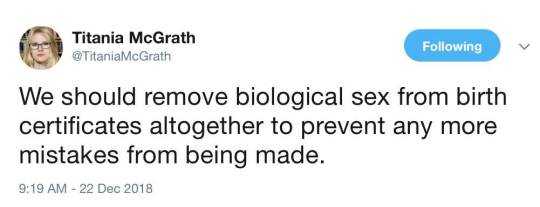
On 17 December 2020, the New England Journal of Medicine concurred.

On 1 October 2019, Titania suggested that young women should be encouraged to travel alone in rural Pakistan.

On 12 October 2019, Forbes Magazine concurred.

On 15 October 2018, Titania argued that Winston Churchill was worse than the Nazis.

On 11 February 2021, Churchill College at Cambridge University concurred.

On 19 September 2018, Titania criticised Julie Andrews (aka Mary Poppins) for chimney soot blackface.

On 28 January 2019, the New York Times concurred.

On 29 April 2019, Titania pointed out that scientists have yet to discover the difference between men and women.

On 24 March 2022, USA Today concurred.


On 22 January 2019, Titania called for the Oscars to prioritise diversity.

On 12 June 2020, the Academy concurred.

On 30 January 2019, Titania accused Laurence Olivier of a hate crime for his performance as Othello.

On 9 October 2021, the University of Michigan concurred.
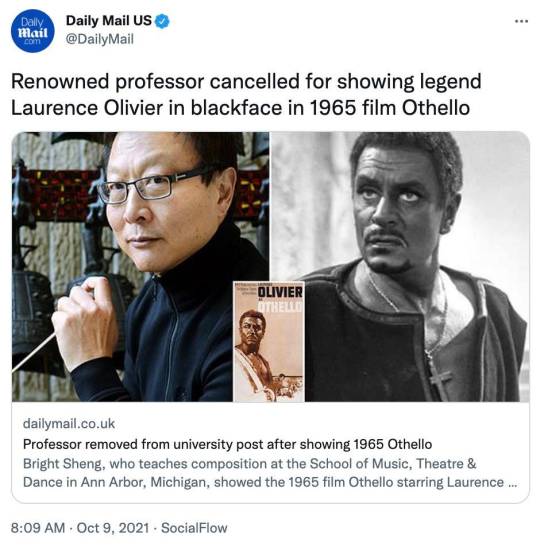
On 2 May 2020, Titania criticised the NHS for appropriating the LGBTQ rainbow flag.

On 6 May 2020, Forbes Magazine concurred.
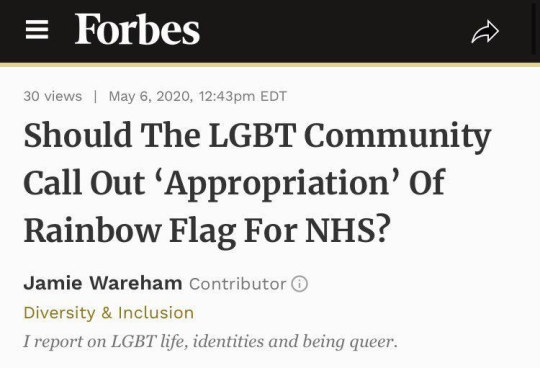
On 6 June 2019, Titania demanded an option on social media to mute white males.
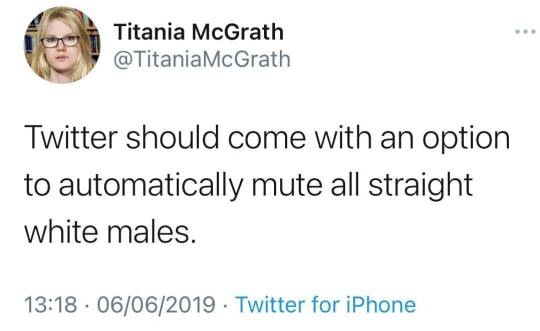
On 14 July 2020, Instagram concurred.

On 12 September 2019, Titania argued that scientists cannot possibly know whether ancient skeletons are male or female.
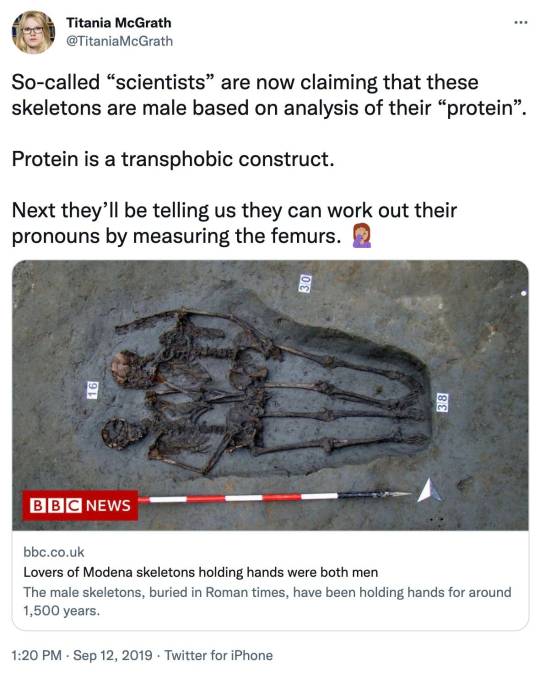
On 18 July 2022, gender activists concurred.

Titania McGrath’s Woke: A Guide to Social Justice is available to buy here. It’s also available on audio book and Kindle.
==
This ideology has become so deranged that it's not possible not parody it anymore. Anything you propose in jest today, they'll take up in sincerity tomorrow. Which shows how performative, directionless and unserious they are.
The Civil Rights and Gay Rights movements had specific aims: eliminate segregation, ensure all laws are race-neutral, that opportunities and resources are available regardless of race, decriminalization of homosexuality, recognition of same-sex partnerships the same as opposite-sex partnerships, including marriage. They were specific, measurable and could be ticked off as they fell.
Woke idiots have no damn clue what they're after. And all they can show us is the stupidest, most petty, most insane non-issues that telegraph to the world they have no real problems to complain about. Elimination of all skyscrapers? A lawsuit over who owns the rainbow? (Fundamentalist Xians would like to get in on that.)
They're just making this crap up as they go along, fighting for who can be the most offended and screaming about their imaginary hurt feelings to garner attention and control.
Why did we ever pay attention to this lunatics?
#Andrew Doyle#Titania McGrath#parody#feminism#intersectional feminism#parody account#LOL#funny#woke#Poe's law#wokeness#cult of woke#wokeism#wokeness as religion#victimhood#victimhood culture#religion is a mental illness
15 notes
·
View notes
Text
Israel is the low-hanging fruit Human Rights Organizations pick on for validation.
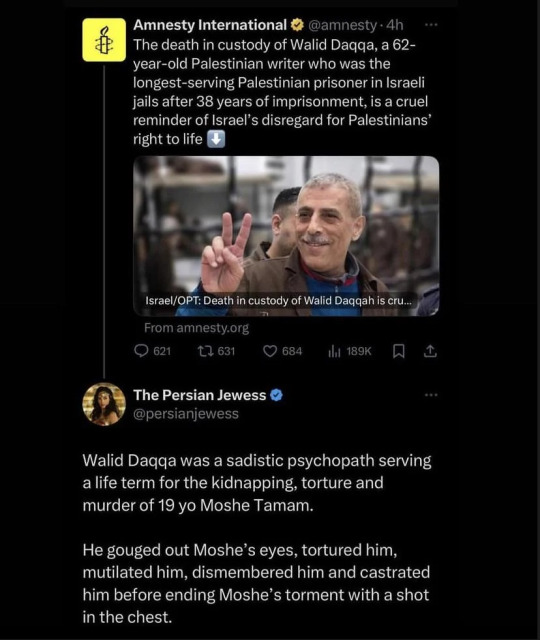
Remember these organizations operate on donations. If you were attempting to maximize donations, which topic would you discuss?
(A) The Uyghur concentration camps in China
(B) The genocide and ethnic cleansing in Sudan
(C) The genocide and ethnic cleansing in Myanmar
(D) One of the worst humanitarian crisis ongoing in Yemen
(E) The terrible human rights violations in Iran
(F) Pakistan expelling two million refugees
(G) Russia's war crimes and massacres in Ukraine
(H) The war in Gaza launched by Hamas
Obviously, the answer is G, as evident by the mind-boggling amount of attention the conflict receives. The popularity of the Israel-Palestine conflict pales in comparison to other global major events and Human Right Organizations know it.
For The Red Cross, Amnesty International and Human Rights Watch It is much more profitable, popular and safer to criticize Israel than Russia, Iran, Sudan, China, Pakistan, Myanmar, Nigeria, Yemen, Syria, Lebanon, etc.
Let's summarize:
The ICRC (International Committee of the Red Cross) has made 6 times more statements to criticize Israel and has often resorted to hyperbole to cast Israel as a “limitless” destroyer to evoke sympathy for one side and demonize Israel. No statement was made speaking directly about the massacre of October 7th. Beyond language, only 2 statements condemning Hamas include videos and pictures while 38 tweets condemning Israel contain images, graphic testimonies, and videos designed to solicit greater attention and a stronger response. Through their Twitter, it is evident that the ICRC has dedicated large amounts of resources to interviewing doctors and victims in Gaza, to editing infographics and videos, and to appearing on the news to talk about the devastation in Gaza. Comparatively little to no attention was paid to Israeli victims.
Human Rights WatcH (HRW) - Is obsessed with criticizing Israel in the conflict and has been called out by their own founder for abandoning their mission and focusing on scrutinizing Israel. HRW disproportionately focuses on condemnations of Israel and that publications related to Israel often lack credibility. HRW also promotes an agenda based solely on the Palestinian narrative of victimization and Israeli aggression.
Amnesty International - Disproportionately singles out Israel for condemnation, focusing solely on the conflict with the Palestinians, misrepresenting the complexity of the conflict, and ignoring more severe human rights violations in the region. In October 2023, in the aftermath of the brutal Hamas attack on October 7, Amnesty emphasized “the root causes” of the conflict, in particular “Israel’s system of apartheid imposed on all Palestinians.” Amnesty does not identify “root causes” on the part of any other actor, including Palestinians and terror groups.
I will reiterate- these organizations follow the wishes of their donors and while their funding isn't fully transparent here are some notable moments:
• In November 2023, MEMRI leaked a document detailing a €3 million donation in 2018 to HRW from Qatar.
• In February 2020, it was revealed that HRW's Executive Director Ken Roth accepted a donation in 2012 from a Saudi real estate tycoon for $470,000 “promising not to support advocacy of the LGBT community in the Middle East and North Africa.”
• In December 2013, Amnesty International admitted to working with the Alkarama foundation, whose Qatari co-founder has been accused of financing Al Qaeda and its affiliates.
• In February 2021, Indian officials accused Amnesty International India of money laundering.
Recommended further reading:
For those complaining I'm relying on UNWatch and NGO-Monitor: Every word is backed by a source which you are encouraged to verify yourself. Anyone refusing to accept factual data because of their cognitive bias should not be discussing this topic in the first place.
Today is the 187 day since Hamas abducted men, women, elders and children from their homes. 133 of them are still in captivity. Ceasefire will only come when Hamas surrenders and releases the hostages.
#hrw#amnesty international#amnesty#Human Rights Watch#ICRC#The International committee of the red Cross#Israel#Palestine#Hamas#Gaza#Hostages#187 days#133 hostages#ceasefire#bring them home#anti Isreal bias#Qatar#Iran#Ken Roth
9 notes
·
View notes
Text
Paris 2024 Athletics: Arshad Nadeem of Pakistan 🇵🇰 Wins Gold In Men’s Javelin Throw, Setting New Olympic Record
— By Annie Fast | 08 August 2024

Picture By Getty Images
It was a record-breaking night at the Stade de France in the Olympic Games Paris 2024 men’s javelin throw final as Pakistan’s Arshad Nadeem set a new Olympic record throw of 92.97m, dominating the field to earn Gold - his first Olympic medal. This win marks Pakistan’s first Olympic gold medal in athletics.
India’s Neeraj Chopra, the Tokyo 2020 defending Gold Medallist, threw a season’s best 89.45 to earn silver. Grenada’s Anderson Peters threw 88.54 to take bronze.
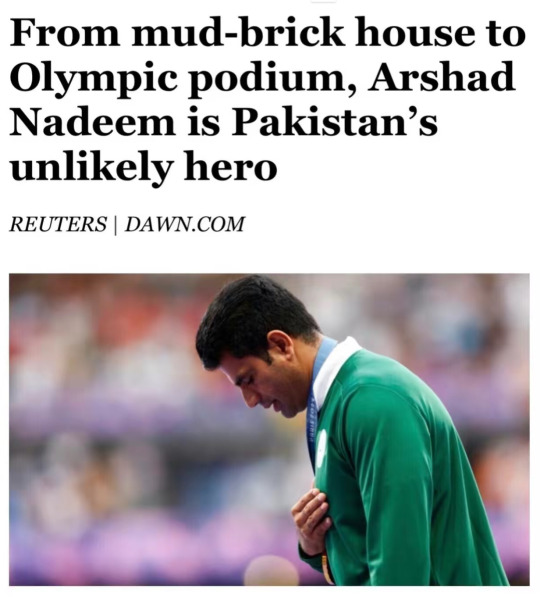
Nadeem is no stranger to making Olympic history, at Tokyo 2020 he was the first Pakistani athlete to qualify for an Olympic athletics final, eventually finishing fifth. At Paris 2024 he has added another page, competing with the support of an Olympic Solidarity Scholarship.
6 notes
·
View notes
Text
Five years since Indian Prime Minister Narendra Modi’s government stripped Jammu and Kashmir of its autonomous status, the central government’s iron-fisted approach to the region has left it more vulnerable to regional and geopolitical threats.
While Kashmir Valley, which has withstood the brunt of armed insurgency since 1989, continues to simmer with militancy-related violence, the theater of terrorism has now extended into the otherwise peaceful province of Jammu. Since 2019, at least 262 soldiers and 171 civilians have died in more than 690 incidents, including the February 2019 Pulwama terrorist attack. The unsustainable and disproportionate loss of lives underscores the risks to both regional stability and India’s national security.
In 2019, the Modi government revoked Article 370 of the Indian constitution, which granted the state of Jammu and Kashmir its special status, annihilating the contested region’s symbolic autonomy. Concurrently, the central government also imposed an indefinite curfew in the region and used internet shutdowns and arrests to control and suppress the local population. The result was a transformed landscape. Already scarred by militarization, Kashmir became enmeshed in barbed wire.
This undemocratic exercise, though later stamped and endorsed by India’s Supreme Court, has since spurred further legal changes. For example, the local population no longer has access to exclusive protections that previously allowed only permanent residents of Jammu and Kashmir to apply for government jobs and buy property in the state.
In March 2020, the government repealed 12 and amended 14 land-related laws, introducing a clause that paved the way for a development authority to confiscate land and another that allowed high-ranking army officials to declare a local area as strategically important.
Local residents are appalled at the ease with which government agencies can now seize both residential and agricultural lands in the name of development and security—enabling mass evictions and the bulldozing of houses that are disproportionately affecting Muslim communities and small landowners.
Meanwhile, the ecological fallout from introducing massive road and railway networks, coupled with the addition of mega hydroelectricity projects, is polluting riverbeds and causing villages to sink. Since 2019, there has been a lack of local representation which could act as a buffer against massive development projects, most of which now fall under New Delhi’s governance. Meanwhile, the region’s unemployment rate, as of 2023, remains high at above 18 percent, as compared to the national average of 8 percent.
Over the last few years, the Modi government has also squashed dissent in the region by redirecting the military to maintain surveillance and control of the civilian population. According to the Forum for Human Rights in Jammu and Kashmir, over 2,700 people were arrested in the region between 2020 and 2023 under India’s contentious Unlawful Activities (Prevention) Act and the Public Safety Act. Those arrested include journalists like Fahad Shah and Sajad Gul, human rights defenders like Khurram Pervez, and prominent lawyers like Mian Qayoom and Nazir Ronga.
Modi’s repressive policies have deepened the trust deficit between Kashmiris and the Indian government. The top-down administration has further sidelined local bureaucrats and police officers, further widening the gap between the central government and local ground realities.
All of this has not only pushed the local population into distress, but also jeopardized India’s already fragile relations with its two nuclear neighbors, Pakistan and China.
The Kashmir conflict, rooted in the 1947 partition of India, has led to three major wars and several military skirmishes between India, Pakistan, and China. And though the region has always been contentious—India controls more than half of the total land, while Pakistan controls 30 percent, and China holds the remaining 15 percent in the northeast region near Ladakh—Modi’s aggressive handling has further provoked its neighbors.
Following the revocation of Article 370, the region was split into two separate union territories—Jammu and Kashmir forming one and Ladakh forming another, with both falling under the central government’s control.
This redrawing of the region’s internal borders, which signaled New Delhi’s assertions of reclaiming the Chinese-occupied territory near Ladakh—as well as India’s increasing tilt towards the United States—resulted in a deadly clash between India and China in 2020 and another one in 2022. Despite diplomatic efforts to resolve tensions over the disputed Himalayan border, New Delhi has accused Beijing of carrying out “inch by inch” land grabs in Ladakh since 2020.
Meanwhile, Pakistan-administered Kashmir has been rocked by mass protests of its own this year, owing to the country’s political and economic crisis, exacerbated in part by the abrogation of Article 370. Those living in Pakistan-administered Kashmir fear that Pakistan may similarly try to dilute the autonomy of the region.
With refugees flooding in from Afghanistan on its west amidst Imran Khan’s standoff with the Pakistani Army, Islamabad has been on edge and looking for diversionary tactics. The deepening of Pakistani-Chinese relations, including military ties, has contributed to a volatile mix.
But Kashmir’s vulnerability has worsened partly because of India’s own tactical blunders, too. The last decade witnessed a spurt in home-grown militancy, but since 2019 the landscape has been dominated by well-trained militants from across the Pakistani border who have access to sophisticated weapons and technology.
Indian security forces, including paramilitaries and the local police, have turned a blind eye to these emerging threats, especially in the twin districts of Rajouri and Poonch along the border with Pakistan. It is in this area that the impact of terror attacks has been most felt.
The region is home to the nomadic Gujjar-Bakerwal communities and the ethnolinguistic Paharis. These groups are parts of divided families straddling the India-Pakistan border, and this shared cultural linkage between the Indian and Pakistani sides has been weaponized in the past by intelligence networks of both countries.
The Indian armed forces have historically relied on the Gujjar-Bakerwal communities for intelligence gathering in part because of their nomadic lives and deep knowledge of the region’s topography. However, since 2019, the evictions of nomads from forest lands, following the amendment of several land-related laws, as well as affirmative actions for Paharis, a rival ethnic group, have led to the disenchantment of the Gujjar-Bakerwals—and an eventual loss of traditional intelligence assets for India.
Another blunder has been the redeployment of troops from Jammu to the border with China in the northeast, following China’s incursions in Ladakh’s Galwan Valley in 2020. This has left Jammu dangerously exposed to militants who have been infiltrating the region from across the line of control on the western side and carrying out their operations with a fair degree of success.
In 2024 alone, Jammu has witnessed numerous attacks which have resulted in the deaths of 16 soldiers and 12 civilians. In June, for example, the region experienced one of its deadliest attacks when militants opened fire on a bus carrying Hindu pilgrims, killing nine and injuring over 30.
Kashmir’s internal politics has the potential to spill over and push the region into disaster. While India has made some significant strides in international diplomacy under Modi, it tends to neglect the neighborhood where the risks to India’s national security remain the highest. Its diplomatic engagement with China comes in fits and starts but diplomacy with Pakistan remains nonexistent, despite the resumption of a ceasefire in 2021. And while India considers the removal of Jammu and Kashmir’s special status an internal matter, Pakistan sees it as a provocation. All in all, there is a dangerous lack of engagement between the two nuclear rivals in South Asia.
In theory, the ongoing regional elections in Jammu and Kashmir provide a glimmer of opportunity for the people to choose their own local government for the first time in a decade. However, irrespective of who wins the elections, the local leaders will lack the power to enact meaningful change, given that the region remains under the control of New Delhi following its demotion from a state to two union territories.
For instance, Ladakh does not have a legislative assembly, and while Jammu and Kashmir have an elected assembly, the real powers are vested in the hands of a governor, who was appointed to lead the region by the Modi-led central government. As recently as July, the Indian government ruled to further expand the governor’s oversight powers, delivering a blow to local politicians and voters.
Much more needs to be done to change the status quo. Though it remains unlikely, New Delhi must consider meaningful solutions that could assuage some of the political wounds inflicted by the complete erosion of Jammu and Kashmir’s autonomy, including, for example, the restoration of statehood to the region. In order to win back the trust of Kashmiris, the Indian government must reinstate civil liberties and deliver on its promise to provide economic development and jobs.
To improve the region’s safety, Indian agencies must acknowledge their security lapses and repair their broken intelligence networks. And while the Indian security forces must not lower their guard against terrorist activities, terrorism should not be proffered as an excuse when it comes to the normalization of relations in the neighborhood.
Neither Pakistan, nor India can afford the war which is looming over their heads. Diplomatic negotiations, including over Kashmir, must begin with a sense of urgency.
3 notes
·
View notes
Text
Holidays 12.6
Holidays
Abolición del Ejército (Costa Rica)
Adore You Day
Armed Forces Day (Ukraine)
Christkind (Central & Southern Europe)
Dia de la Constitucion (a.k.a. Constitution Day; Spain)
Dogecoin Day
Dubrovnik Defenders’ Day (Croatia)
Ed Tech Appreciation Day
Encyclopedia Britannica Day
Give a Secret Gift Day
Gorse Day (French Republic)
Gospell Day (Marshall Islands)
Gramophone Day
Halifax Explosion Anniversary Day (Canada)
Ice Cube Day (Astronomy Club)
International Bad Hair Day
International Desk Day
International Femicide Remembrance Day
International Memecoin Day
International Sweater Vestival
Main Directorate for Drug Control Day (Russia)
Miner's Day (West Virginia)
Ministry of Communications and Information Technologies Day (Azerbaijan)
Mitten Tree Day
Musical Instrument Gift Day
National Day of Remembrance and Action on Violence Against Women (Canada)
National Microwave Oven Day
National Miner's Day
National Pawnbrokers Day
National Sunnies Day (Australia)
National Tell Your Best Friend You Love Them Day
National Travis Day
Prosecutor’s Day (Kazakhstan)
Put On Your Own Shoes Day
Sindhi Topi and Ajrak Day (Pakistan)
Food & Drink Celebrations
Make & Bake Day
National ‘Cook For Christmas’ Day
National Gazpacho Day
Pizza Day (Google)
Samichlaus Day
Independence & Related Days
Åland Islands (from Russia, 1917)
Bophuthatswana (from South Africa, 1977)
Constitution Day (Spain)
Finland (from Russia, 1917)
Ireland (from the UK, recognized in 1922)
Kingdom of Titan (Declared; 2020) [unrecognized]
Quito Day (Ecuador)
Western Province Day (Solomon Islands)
1st Friday in December
Bandcamp Friday [1st Friday]
Bartender Appreciation Day [1st Friday]
Comfort Food Friday [Every Friday]
Eccentric Day (Bell's Brewery; Michigan) [1st or 2nd Friday or Another Day]
Farmer’s Day (Ghana) [1st Friday]
Faux Fur Friday [1st Friday]
Five For Friday [Every Friday]
Flashback Friday [Every Friday]
Friday Finds [Every Friday]
Fry Day (Pastafarian; Fritism) [Every Friday]
Gospel Day (Marshall Islands) [1st Friday]
International Sweater Vestival [2nd Friday after Thanksgiving]
National Salesperson Day [1st Friday]
Open It! Weekend begins [1st Friday]
Purple Friday (UK) [1st Friday]
Saba Day (a.k.a. Flag Day; Netherlands Antilles) [1st Friday]
TGIF (Thank God It's Friday) [Every Friday]
Weekly Holidays beginning December 6 (1st Full Week of December)
Deck the Halls Weekend (Seneca Lake region, New York) [thru 12.8]
Festivals Beginning December 6, 2024
Candlelight Christmas Walk (Augusta, Missouri) [& 12.13]
Christmas Town Festival (Bethlehem, Connecticut) [thru 12.7]
Colisium International Music Forum (Novosibirsk, Russia) [thru 12.7]
Country Christmas Lighted Farm Implement Parade (Sandusky, Michigan) [thru 12.7]
German Christmas Market (Augusta, New Jersey) [thru 12.8]
Gingerbread Celebration and Holiday Mart (Gettsburg, Pennsylvania) [thru 12.8]
Gingerbread Village (Caro, Michigan) [thru 12.7]
Kimmswick Christmas Festival (Kimmswick, Missouri) [thru 12.8]
Medora's Old Fashioned Cowboy Christmas (Medora, North Dakota) [thru 12.8]
Night of the Proms (Munich, Germany)
Oslo Christmas Market (Oslo, Norway) [thru 12.7]
PAX Unplugged (Philadelphia, Pennsylvania) [thru 12.8]
Salon du Cheval de Paris (Paris, France) [thru 12.8]
Southport Holiday Stroll & Cocktail Crawl (West Lakeview, Illinois)
Stockbridge Main Street At Christmas (Stockbridge, Massachusetts) [thru 12.8]
St. Paul Ice Fishing & Winter Sports Show (St. Paul, Minnesota) [thru 12.8]
St. Petersburg Fall Seafood & Music Festival (St. Petersburg, Florida) [thru 12.8]
Tree Lighting and Holiday Parade (Batesville, Indiana)
Feast Days
Abraham of Kratia (Christian; Saint)
Aemilianus (Roman Catholic Church)
Akibasan Gongen Hibuse Matsuri (Fire & Water Festival; Japan)
Bodhi Season, Day 6 (Buddhism; Secular Date) [Leading Up to 12.8] (a.k.a. ...
Principles: Perfection
Secular: Trip to Your Bodhi Day Place
Eightfold Path: Awakened Effort
The Heart Sutra: Issue Me Ke Kanaka Wai Wai (Jesus and the Rich Man)
Crossover Doozer (Muppetism)
Day of the North Wind (Pagan)
Days of Reckoning Begin (Shamanism)
Denise and companions (Christian; Saints)
Dionysia, Dativa, Aemilianus, Boniface, Leontia, Tertius, and Majoricus (Christian; Martyrs)
Doug Marlette (Artology)
Eliot Porter (Artology)
Frank Springer (Artology)
Frédéric Bazille (Artology)
Gamera Day (Church of the SubGenius; Saint)
Henk van Woerden (Artology)
Insult a Religious Fanatic Day (Pastafarian)
James Bernouilli (Positivist; Saint)
János Scheffler (Christian; Blessed)
Joyce Kilmer (Writerism)
Mall Nukke (Artology)
María del Monte Carmelo Sallés y Barangueras (Christian; Saint)
Masami Kurumada (Artology)
Math Ap Mathonwy (Celtic Book of Days)
Nicholas of Myra (Christian; Saint) [brewers]
Nicola De Maria (Artology)
Peter Paschal (Christian; Saint)
Pirate Appreciation Day (Pastafarian)
Rudolf Schlichter (Artology)
Shio Satō (Artology)
Theophilus, Bishop of Antioch (Christian; Saint)
Thor's Day (Norse)
Turnover (The Seasons of Earnings begins; Church of the SubGenius)
Lucky & Unlucky Days
Butsumetsu (仏滅 Japan) [Unlucky all day.]
Tycho Brahe Unlucky Day (Scandinavia) [35 of 37]
Unglückstage (Unlucky Day; Pennsylvania Dutch) [28 of 30]
Very Unlucky Day (Grafton’s Manual of 1565) [56 of 60]
Premieres
Adaptation (Film; 2002)
Aeronauts (Film; 2019)
As Good As It Gets (Film; 1997)
Beggar’s Banquet, by The Rolling Stones (Album; 1968)
Bullseye Bullwinkle, or Destination Moose (Rocky & Bullwinkle Cartoon, S1, Ep. 3; 1959)
Cinderella (Ub Iwerks Disney Cartoon; 1922)
Cock-a-Doodle Dino (Noveltoons Cartoon; 1957)
Day Tripper, by The Beatles (Song; 1965)
A Dopey Hacienda (Tijuana Toads Cartoon; 1970)
DuBarry Was A Lady (Broadway Musical; 1939)
Dumb and Dumber (Film; 1994)
Ferry Cross the Mersey (Documentary Film; 1964)
The Fox and the Grapes (Color Rhapsody Cartoon; 1941)
Gimme Shelter (Concert Film; 1970)
Going To A Go-Go, by Smokey Robinson and the Miracles (Song; 1965)
The Hand of Oberon, by Roger Zelazny (1976) [Chronicles of Amber #4]
A Hard Rain’s A-Gonna Fall, recorded by Bob Dylan (Song; 1962)
The Hep Cat (Mighty Mouse Cartoon; 1946)
Hip Hip-Hurry! (WB MM Cartoon; 1958)
King-Size Canary (Tex Avery MGM Cartoon; 1947)
The Lake District Murder, by Ernest Elmore, writing as John Bude (Novel; 1935)
Live at the BBC, by The Beatles (Compilation Album; 1994)
Mary Had a Little Lamb, recorded by Thomas Edison (Song; 1877) [1st Recording of the Human Voice]
Mr. Willowby’s Christmas Tree (Muppet TV Special; 1995)
The Night Before Christmas (Tom & Jerry Cartoon; 1941)
19th Nervous Breakdown, recorded by The Rolling Stones (Song; 1965)
One Droopy Night (Droopy MGM Cartoon; 1957)
Out of an Old Man’s Head (Swedish Animated Film; 1968)
Popeye (Film; 1980)
Red Bank Boogie, recorded by The Count Basie Orchestra (Song; 1944)
Rubber Soul, by The Beatles (Album; 1965)
Rudolph the Red-Nosed Reindeer (Animated TV Special; 1964)
Running on Empty, by Jackson Browne (Live Album; 1977)
Sixteen Stone, by Bush (Album; 1994)
Smoke on the Water, recorded by Deep Purple (Song; 1971)
Squeeze Play or Invitation to the Trance (Rocky & Bullwinkle Cartoon, S1, Ep. 4; 1959)
Star Trek VI: The Undiscovered Country (Film; 1991)
Still Crazy After All These Years, by Paul Simon (Album; 1975)
The Story of an Hour, by Kate Chopin (Short Story; 1894)
The Stroll, by The Diamonds (Song; 1957)
Sympathy for the Devil, by The Rolling Stones (Song; 1968)
Tommy Tucker’s Tooth (Disney Cartoon; 1922)
Turn! Turn! Turn!, by The Byrds (Album; 1965)
We Can Work It Out, by The Beatles (Song; 1965)
Whole Lotta Love, by Led Zeppelin (Song; 1969)
Today’s Name Days
Denise, Henrike, Nikolaus (Austria)
Nikola, Nikolai, Nina (Bulgaria)
Nikica, Niko, Nikola, Nikša, Vladimir (Croatia)
Mikuláš (Czech Republic)
Nikolaus (Denmark)
Klaus, Laas, Laus, Nigul, Nigulas, Niilas, Niilo, Nikolai, Nils (Estonia)
Niila, Niilo, Niki, Niklas, Niko, Nikolai, Nikolas (Finland)
Nicolas (France)
Denise, Henrike, Nikolaus (Germany)
Nikolaos, Nikoleta, Nikos (Greece)
Miklós (Hungary)
Nicola (Italy)
Klāvs, Niklāvs, Nikolajs (Latvia)
Bilmantas, Mikalojus, Norvydė (Lithuania)
Nikolai, Nils (Norway)
Dionizja, Emilian, Jarema, Jarogniew, Mikołaj (Poland)
Nicolae (România)
Mikuláš (Slovakia)
Nicolás (Spain)
Niklas, Nikolaus (Sweden)
Nicholas (Ukraine)
Claus, Ira, Nicholas, Nichole, Nicholet, Nick, Nicklaus, Nickolas, Nico, Nicolas, Nicole, Nicolette, Nikki, Niko, Nikolas (USA)
Today is Also…
Day of Year: Day 341 of 2024; 25 days remaining in the year
ISO: Day 5 of Week 49 of 2024
Celtic Tree Calendar: Ngetal (Reed) [Day 13 of 28]
Chinese: Month 11 (Bing-Zi), Day 6 (Jia-Chen)
Chinese Year of the: Dragon 4722 (until January 29, 2025) [Wu-Chen]
Hebrew: 5 Kislev 5785
Islamic: 4 Jumada II 1446
J Cal: 11 Black; Foursday [11 of 30]
Julian: 23 November 2024
Moon: 29%: Waxing Crescent
Positivist: 5 Bichat (13th Month) [Römer / Bradley]
Runic Half Month: Is (Stasis) [Day 15 of 15]
Season: Autumn or Fall (Day 75 of 90)
Week: 1st Full Week of December
Zodiac: Sagittarius (Day 15 of 30)
2 notes
·
View notes
Text
Tuesday, October 15, 2024
Florida neighbors band together to recover (AP) When ankle-deep floodwaters from Hurricane Helene bubbled up through the floors of their home, Kat Robinson-Malone and her husband sent a late-night text message to their neighbors two doors down: “Hey, we’re coming.” The couple waded through the flooded street to the elevated front porch of Chris and Kara Sundar, whose home was built on higher ground, and handed over their 8-year-old daughter and a gas-powered generator. The Sundars’ lime-green house in southern Tampa also became a refuge for Brooke and Adam Carstensen, whose house next door to Robinson-Malone also flooded. The three families met years earlier when their children became playmates, and the adults’ friendships deepened during the coronavirus pandemic in 2020. So when Helene and Hurricane Milton struck Florida within two weeks of each other, the neighbors closed ranks as one big extended family, cooking meals together, taking turns watching children and cleaning out their damaged homes. “Everyone has, like, the chain saw or a tarp,” Robinson-Malone said Sunday. “But really the most important thing for us was the community we built. And that made all the difference for the hurricane rescue and the recovery. And now, hopefully, the restoration.”
Thousands march in Spain to demand affordable housing (Reuters) Thousands protested on Sunday in Madrid to demand more affordable housing amid rising anger from Spaniards who feel they are being priced out of the market. “Spaniards cannot live in their own cities. They are forcing us out of the cities,” said nurse Blanca Prieto, 33. Spain is struggling to balance promoting tourism, a key driver of its economy, and addressing citizens’ concerns over unaffordable high rents due to gentrification and landlords shifting to more lucrative tourist rentals. Residents of the Canary Islands and Malaga have also staged protests this year against the rise in tourist rentals. Seasonal hospitality workers struggle to find accommodation in these tourism hot spots, with many resorting to sleeping in caravans or even their cars.
Russian Strikes on Ukrainian Ports Target Shipping (NYT) Russia has stepped up its assaults on Black Sea port infrastructure and civilian shipping in recent days, in what Ukraine says is an attempt to disrupt its exports and damage its economy. The attacks are part of an intensifying campaign of strikes on the city of Odesa and the region along Ukraine’s southern coast. Since last Monday, Russia has carried out five attacks in the area, killing 14 civilians and injuring 28, the U.N.’s Human Rights Monitoring Mission in Ukraine reported on Friday, citing local authorities. The strikes on ships were mostly aimed at those flying flags of small countries unlikely to retaliate against Russia. Last Monday, a container ship under the flag of Palau was hit, Ukrainian official said. The day before that, a missile damaged a vessel under a Saint Kitts and Nevis flag, according to the regional military administration.
Pakistan’s internet slows to a crawl as blame falls on government (Washington Post) Mobile internet in Pakistan has been painfully slow for over two months. Now, technology experts and political activists are accusing the government of intentionally throttling the internet to suppress political protesters. Digital rights activists fear that Pakistani officials are installing new controls to more tightly monitor social media and to censor political content.
China’s ‘New Great Wall’ Casts a Shadow on Nepal (NYT) The Chinese fence traces a furrow in the Himalayas, its barbed wire and concrete ramparts separating Tibet from Nepal. Here, in one of the more isolated places on earth, China’s security cameras keep watch alongside armed sentries in guard towers. High on the Tibetan Plateau, the Chinese have carved a 600-feet-long message on a hillside: “Long live the Chinese Communist Party,” inscribed in characters that can be read from orbit. Just across the border, in Nepal’s Humla District, residents contend that along several points of this distant frontier, China is encroaching on Nepali territory. The Nepalis have other complaints, too. Chinese security forces are pressuring ethnic Tibetan Nepalis not to display images of the Dalai Lama, the exiled Tibetan spiritual leader, in Nepali villages near the border, they say. “This is the new Great Wall of China,” said Jeevan Bahadur Shahi, the former provincial chief minister of the area. China’s fencing along the edge of Nepal’s Humla District is just one segment of a fortification network thousands of miles long that Xi Jinping’s government has built to reinforce remote reaches, control rebellious populations and, in some cases, push into territory that other nations consider their own.
Sri Lanka closes schools as floods hammer the capital (AP) Sri Lanka closed schools in the capital Colombo and suburbs on Monday as heavy rains triggered floods in many parts of the island nation. Heavy downpours over the weekend have wreaked havoc in many parts of the country, flooding homes, fields and roads. Three people drowned, while some 134,000 people have been affected by flooding, according to the country’s Disaster Management Centre. Sri Lanka has been grappling with severe weather conditions since May, mostly caused by heavy monsoon rains. In June, 16 people died due to floods and mudslides.
Can the Government Get People to Have More Babies? (NYT) In 1989, Japan seemed to be an unstoppable economic superpower. Its companies were overtaking competitors and gobbling up American icons like Rockefeller Center. But inside the country, the government had identified a looming, slow-motion crisis: The fertility rate had fallen to a record low. Policymakers called it the “1.57 shock,” citing the projected average number of children that women would have over their childbearing years. If births continued to decline, they warned, the consequences would be disastrous. Taxes would rise or social security coffers would shrink. Japanese children would lack sufficient peer interaction. Society would lose its vitality as the supply of young workers dwindled. It was time to act. Starting in the 1990s, Japan began rolling out policies and pronouncements designed to spur people to have more babies. The government required employers to offer child care leave of up to a year, opened more subsidized day care slots, exhorted men to do housework and take paternity leave, and called on companies to shorten work hours. In 1992, the government started paying direct cash allowances for having even one child (earlier, they had started with the third child), and bimonthly payments for all children were later introduced. None of this has worked. Last year, Japan’s fertility rate stood at 1.2. In Tokyo, the rate is now less than one. The number of babies born in Japan last year fell to the lowest level since the government started collecting statistics in 1899. Now the rest of the developed world is looking more and more like Japan.
The Brewing War With Israel Is Boosting Iran’s Young Hard-Liners (Foreign Affairs) The Islamic Revolutionary Guard Corps, Iranian Supreme Leader Ali Khamenei’s influential, ideological armed force, has been riven by divisions between its older, conservative commanders and its younger, radical ranks. The former generally favor exercising some restraint when it comes to Israel, whereas the latter want to go directly after the Islamic Republic’s nemesis. Typically, the older elite have held more influence with the supreme leader. But as more and more IRGC commanders and partners have been killed, the younger generations have gained the upper hand. They have done so by questioning the competence of their elders but also by suggesting that some IRGC elites are actually Israeli assets, including Esmail Ghaani, the IRGC commander who controls Iran’s Quds force—which, in turn, controls Iran’s network of proxy militias. After Israel killed Nasrallah, Khamenei’s calculus appears to have been shaped by this younger cohort. It is part of why Khamenei launched the October 1 attack.
Netanyahu Is Killing Us To Set Us Free? Logic, Grief And Resistance In Beirut (Daraj/Lebanon) Israeli Prime Minister Benjamin Netanyahu addressed us, the Lebanese people, and offered us a gift: a massacre. He sent soldiers to the Lebanese border town of Maroun al-Ras, raised an Israeli flag there, and sent the picture to the whole world. Netanyahu, who has so far killed more than 40,000 Palestinians and about 3,000 Lebanese, addressed us directly—and said that he is killing us for the sake of our future [by destroying Hezbollah]. Netanyahu tells us that he wants to give us after killing us, a homeland, one that is no more than a graveyard and no less than a colony. This speech he addressed to us is truly amazing, a summary of what awaits us if Netanyahu, owner of the “massacre doctrine,” achieves what he wants.
U.S. to Deploy Missile Defense System and About 100 Troops to Israel (NYT) The United States is sending an advanced missile defense system to Israel, along with about 100 American troops to operate it, the Pentagon announced on Sunday. The move will put American troops operating the ground-based interceptor, which is designed to defend against ballistic missiles, closer to the widening war in the Middle East. It comes after Iran launched about 200 missiles at Israel on Oct. 1 and as Israel plans its retaliatory attack. The THAAD battery, a mobile defense system, will give the Israel Defense Forces another layer of protection to defend cities, troops and installations from short- and intermediate-range ballistic missiles like those deployed by Iran in its last attack.
Netanyahu tells U.S. that Israel will strike Iranian military, not nuclear or oil, targets, officials say (Washington Post) Israeli Prime Minister Benjamin Netanyahu has told the Biden administration he is willing to strike military rather than oil or nuclear facilities in Iran, according to two officials familiar with the matter, suggesting a more limited counterstrike aimed at preventing a full-scale war. In the two weeks since Iran’s latest missile barrage on Israel, its second direct attack in six months, the Middle East has braced for Israel’s promised response, fearing the two countries’ decades-long shadow war could explode into a head-on military confrontation. It comes at a politically fraught time for Washington, less than a month before the election, and President Joe Biden has said publicly he would not support an Israeli strike on nuclear-related sites. When Biden and Netanyahu spoke Wednesday—their first call in more than seven weeks after months of rising tensions between the two men—the prime minister said he was planning to target military infrastructure in Iran, according to a U.S. official and an official familiar with the matter.
Is Israel deploying a ‘surrender or starve’ strategy in Gaza? (Washington Post) Northern Gaza, already pummeled by a year of ruinous war, is in the grips of a punishing new Israeli offensive. Israeli forces encircled the battered Jabalya refugee camp in a bid to “systematically dismantle terrorist infrastructure,” according to an IDF statement. Israel issued evacuation orders to some 400,000 remaining residents in northern Gaza, telling them to go to areas farther south that are already teeming with the displaced and still hit by Israeli bombardments. Airstrikes have killed dozens. Aid workers described a catastrophic scene. “It is like hell to be honest,” Fares Afana, the head of ambulance services in northern Gaza, told The Washington Post in a voice note on Sunday. Israeli forces were attacking the Jabalya refugee camp “for the third time and its surroundings in Beit Lahya and Beit Hanoun,” Afana said, and the camp was surrounded “from all sides.” Humanitarian organization Doctors Without Borders said Friday that thousands of people—including five of its staffers—were trapped in the Jabalya camp. “Nobody is allowed to get in or out—anyone who tries is getting shot,” Sarah Vuylsteke, a project coordinator for the organization, said in a news release. The intensifying siege will “continue as long as required in order to achieve its objectives,” the IDF said in a statement. It comes alongside an apparent blockade. No food trucks have entered at all in October. Such a tactic may fuel further accusations that Israel is deliberately starving Palestinians in Gaza.
2 notes
·
View notes
Text
Martin Pengelly at The Guardian:
Mark Milley, a retired US army general who was chair of the joint chiefs of staff under Donald Trump and Joe Biden, fears being recalled to uniform and court-martialed should Trump defeat Kamala Harris next month and return to power. “He is a walking, talking advertisement of what he’s going to try to do,” Milley recently “warned former colleagues”, the veteran Washington Post reporter Bob Woodward writes in an upcoming book. “He’s saying it and it’s not just him, it’s the people around him.”
Woodward cites Steve Bannon, Trump’s former campaign chair and White House strategist now jailed for contempt of Congress, as saying of Milley: “We’re gonna hold him accountable.” Trump’s wish to recall and court-martial retired senior officers who criticized him in print has been reported before, including by Mark Esper, Trump’s second secretary of defense. In Woodward’s telling, in a 2020 Oval Office meeting with Milley and Esper, Trump “yelled” and “shouted” about William McRaven, a former admiral who led the 2011 raid in Pakistan in which US special forces killed Osama bin Laden, and Stanley McChrystal, the retired special forces general whose men killed another al-Qaida leader, Abu Musab al-Zarqawi, in Iraq in 2006. Milley was able to persuade Trump to back down, Woodward writes, but fears no such guardrails will be in place if Trump is re-elected.
Woodward also describes Milley receiving “a non-stop barrage of death threats” since his retirement last year, and quotes the former general as telling him, of Trump: “No one has ever been as dangerous to this country.” Milley spoke to Woodward for his previous reporting. Woodward now reports the former general as saying: “He is the most dangerous person ever. I had suspicions when I talked to you about his mental decline and so forth, but now I realize he’s a total fascist. He is now the most dangerous person to this country. “A fascist to the core.” Woodward, 81, made his name in the 1970s with Carl Bernstein during Watergate, the scandal that brought down Richard Nixon. Woodward’s new blockbuster, War, will be published on Tuesday. His fourth book at least in part about Trump – after Fear, Rage, and Peril – stoked uproar this week with the release of revelations including that Trump sent Covid testing machines to Vladimir Putin early in the coronavirus pandemic, and that Trump has had as many as seven phone calls with the Russian president since leaving office.
Milley was chair of the joint chiefs of staff from 2019 to 2023. His attempts to cope with Trump have been widely reported – particularly in relation to Trump’s demands for military action against protesters for racial justice in the summer of 2020 and, later that year, Trump’s attempt to stay in power despite losing the election to Biden. Last year, marking his retirement, Milley appeared to take a direct swipe at Trump, then a candidate for a third successive Republican presidential nomination. “We don’t take an oath to a king, or queen, or tyrant or a dictator, and we don’t take an oath to a wannabe dictator,” Milley told a military audience at Joint Base Myer-Henderson Hall in Arlington, Virginia. “We don’t take an oath to an individual. We take an oath to the constitution, and we take an oath to the idea that is America, and we’re willing to die to protect it.”
In Bob Woodward’s soon-to-be released book War, Gen. Mark Milley rightly called Donald Trump “a fascist to the core.”
Let’s defeat fascism by electing Kamala Harris!
See Also:
HuffPost: In Bob Woodward's New Book, Retired Gen. Mark Milley Calls Trump ‘A Total Fascist’
4 notes
·
View notes
Photo








Wat? School Boys (2021) door Salman Toor, Patrizia Cavalli’s Christmas Table (2020), Studio Nude (2022), The Lake (2019) en Tom sleeping at Locarno with etchings (2020) door Louis Fratino en Wet Hands (2015), Companion (2019) en Kompleks (2016) door Sanya Kantarovsky
Waar? Tentoonstelling Brave New World in Museum De Fundatie, Zwolle
Wanneer? 5 maart 2023
Salman Toor is afkomstig uit Pakistan en verhuisde naar Amerika. Zijn schildersloopbaan verliep stroef tot het Whitney Museum in New York in één zaal een kleine expositie van zijn werk organiseerde. Daarna schoot zijn carrière als een raket omhoog. Zodanig dat er nu haast geen werk van hem te krijgen is. Er hangt dan ook slechts één klein werk van hem op deze tentoonstelling in Zwolle. Toor is homoseksueel en die geaardheid speelt in zijn werk een belangrijke rol. Op School Boys staan twee jongens tegen een muur. Ze kijken elkaar niet aan, maar toch lijkt er een zeker spanning tussen de twee te bestaan.
Queerness speelt ook een grote rol in het werk van de Amerikaan Louis Fratino. Hij gunt ons via zijn schilderijen een blik in zijn leven, waarbij zijn homoseksuele geaardheid haast terloops langskomt. Daarbij verwijst hij regelmatig naar de kunstgeschiedenis. Patrizia Cavalli’s Christmas Table refereert aan werk van Matisse, Studio Nude doet denken aan Pablo Picasso en The Lake heeft duidelijke overeenkomsten met het werk van Chagall. Mijn favoriete werkje van deze kunstenaar is een heel klein doekje. Het toont een slapende jongeman onder een wit laken met op de achtergrond een ets: Tom sleeping at Locarno with etchings.
Sanya Kantarovsky is geboren in Moskou en woont en werkt in New York. Haar werken zijn qua stijl heel verschillend, maar allemaal virtuoos geschilderd. Het kleurrijke Wet Hands is net zo fascinerend als het haast monochrome Companion (wie houdt hier trouwens wie gezelschap?). Een bijzonder spannend werk vind ik Kompleks. We zien een jongetje met een steek op het hoofd tussen twee volwassenen. Proberen de grote mensen het kind te beschermen of vormen ze een bedreiging voor hem? De vrouw rechts van het jongetje heeft een stevige greep om zijn arm. De man links van hem steekt, haast dreigend, zijn hand uit. Wil hij de steek van het jongetje afnemen of het jongetje zelf beetpakken? Het jongetje kijkt van onder zijn steek naar de man. Is zijn blik wantrouwend, angstig? Op de achtergrond is een groot gebouwencomplex zichtbaar dat Oostblok-achtig en monotoon oogt.
30 notes
·
View notes
Text
multiculturalism vs multiracial organizing & solidarity
Two from Novara Media
We Can’t Dismantle Capitalism Without Antiracist Solidarity: Cross-community organising is key.
by Sonali Bhattacharyya, Novara Media (9 August 2021)
My dad was a lecturer and a trade unionist, my mum a social worker, both from India via what is now Bangladesh. They saw no distinction between the racist abuse they experienced and that experienced by their colleagues who originated from Pakistan or the Caribbean. In their eyes, they were all being exploited under the same unjust system.
If you look at photos of iconic acts of resistance from that era – protests against the violent racism that led to the murder of Altab Ali, the police brutality faced by visitors to the Mangrove, or the picket lines in support of the strikers at Grunwick – you’ll see the working class in all its diversity.
How State-Sanctioned Multiculturalism Killed Radical Anti-Racism in Britain: Enter the rainbow nation.
by Ilyas Nagdee & Azfar Shafi, Novara Media (21 June 2022)
In this way, antiracism from above became entangled with the British state rather than presenting an opposition to it. Multiculturalism served as a means for the state to manage the contradictions of governing a racist society without meaningfully addressing them – instead enveloping them a dense vocabulary of ‘culture’, ‘ethnicity’, ‘diversity’, ‘identity’ and so on.
At worst, multiculturalism provided an alibi for racist state agencies. This contradiction was laid bare in a pamphlet by the National Convention of Black Teachers on policing and race training, highlighting how between 1981 and 1984: “[The] police training establishment implemented a number of new programmes. So that cadets, recruits and officers may now be taught multi-agency policing methods in the morning and commando work in the afternoon: multiculturalism in one course and the use of plastic bullets in the next: concepts of American-imported racism-awareness on the one hand and Northern Ireland style repression on the other.”
As multiculturalism was elevated to an ideology of governance, racism itself was emptied of its ideological substance. This was underlined by the response to policing following the 1981 uprisings, whereby the question of state racism which the police were enforcing became recast as a matter of racial attitudes among the police. More broadly, structural racism was refashioned as an issue of managing racist attitudes and interpersonal hostility. This in turn held the door open for apolitical and procedural ‘solutions’ to racism – such as the new racism awareness trainings prescribed by professional antiracists.
After the 1981 uprisings, such professionals were drawn from the ranks of organisations like the Racism Awareness Programme Unit (RAPU) to help in smoothing out the hard edges of the police force. Nearly 40 years later, their US counterparts were soothing the hearts of white America, as Robin DiAngelo’s White Fragility shot to the top of bestseller lists at the height of the 2020 Black Lives Matter protests. Labour leader Keir Starmer’s warmest gesture towards the protests was to prescribe unconscious bias training for his MPs. And before the dust had settled, race consultants on both sides of the Atlantic were polishing up their portfolios and waxing lyrical about their ‘anti-oppression workshops’ and ‘antiracist dinner parties’, like shameless antiracist ambulance chasers.
6 notes
·
View notes